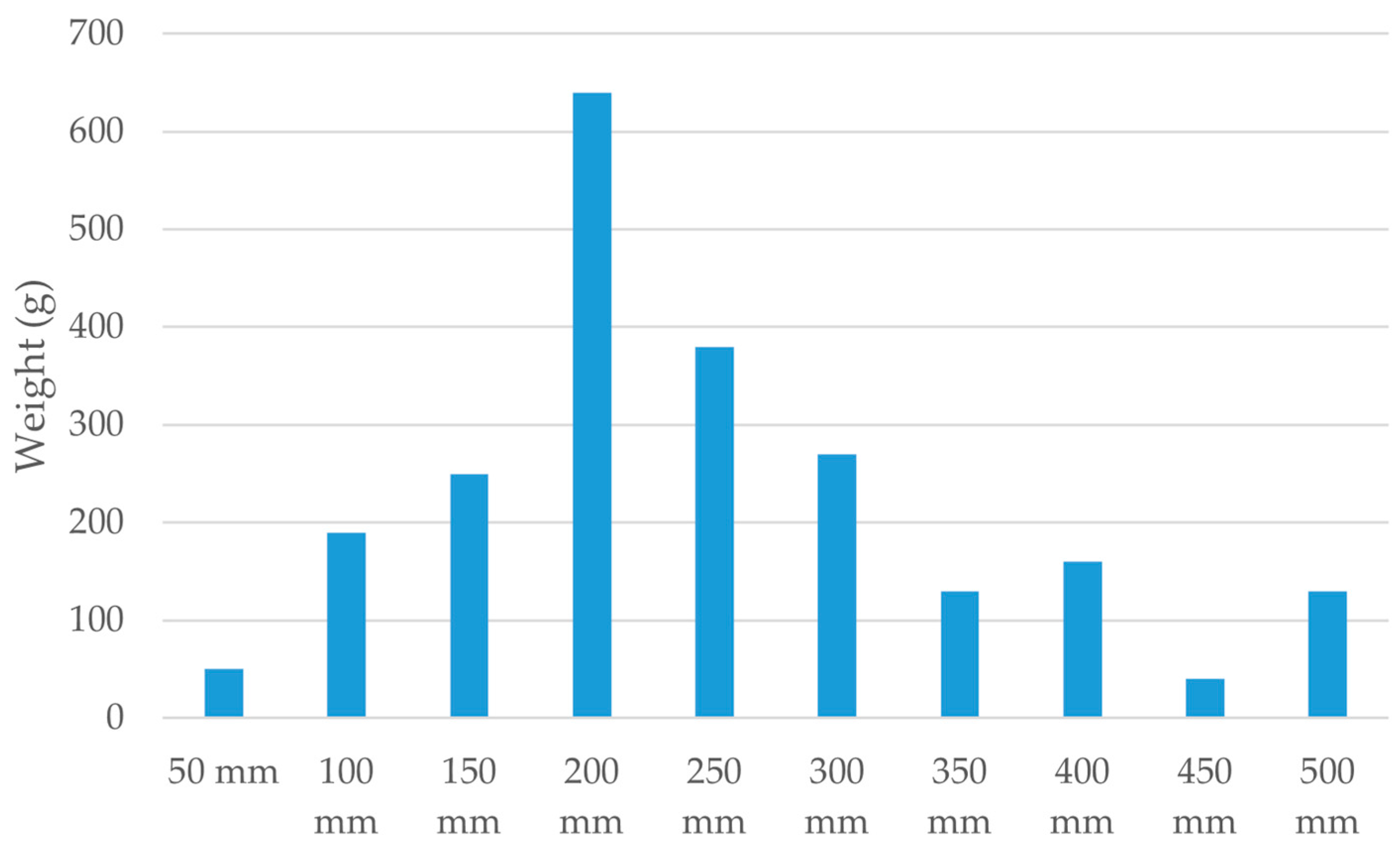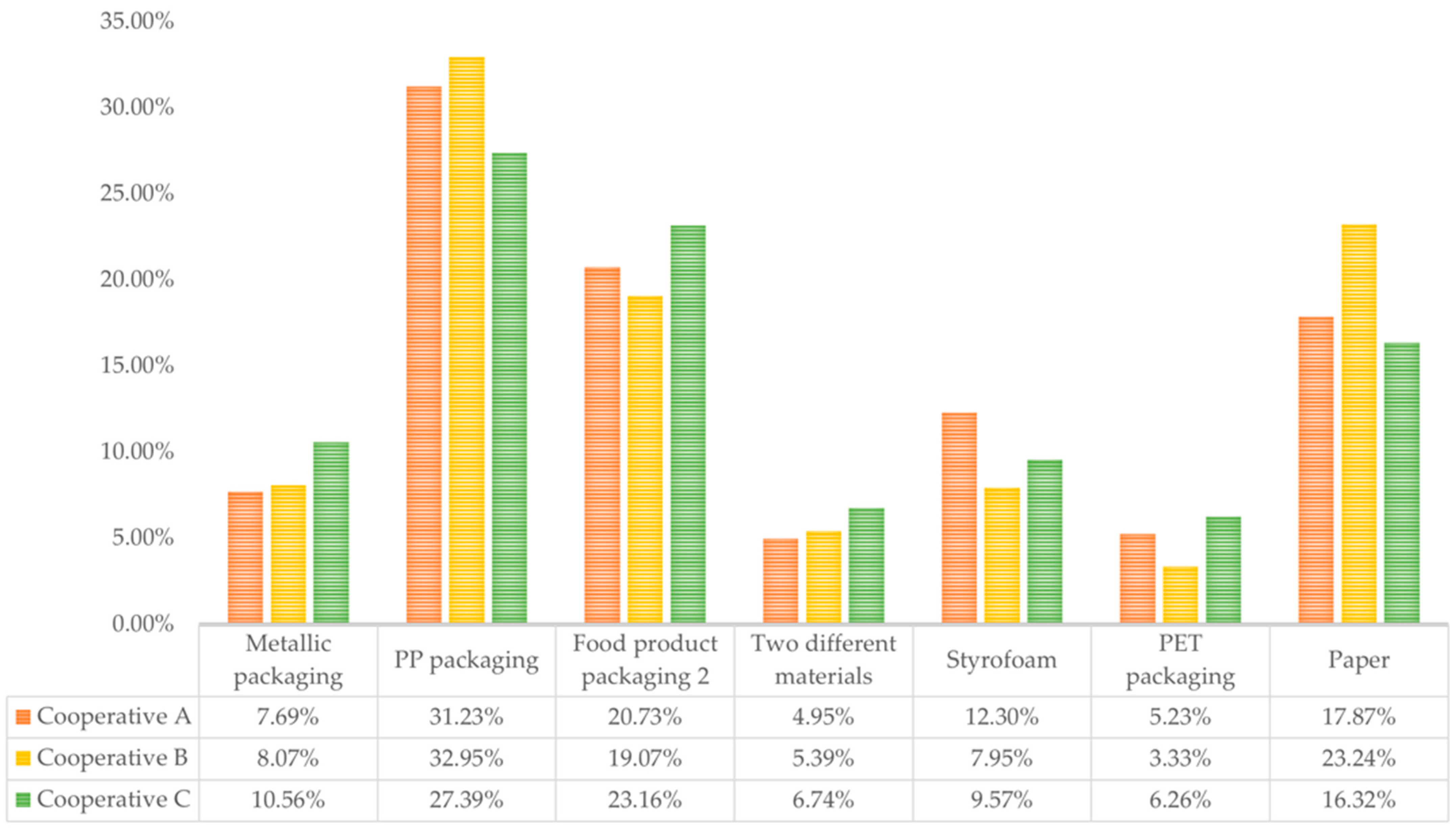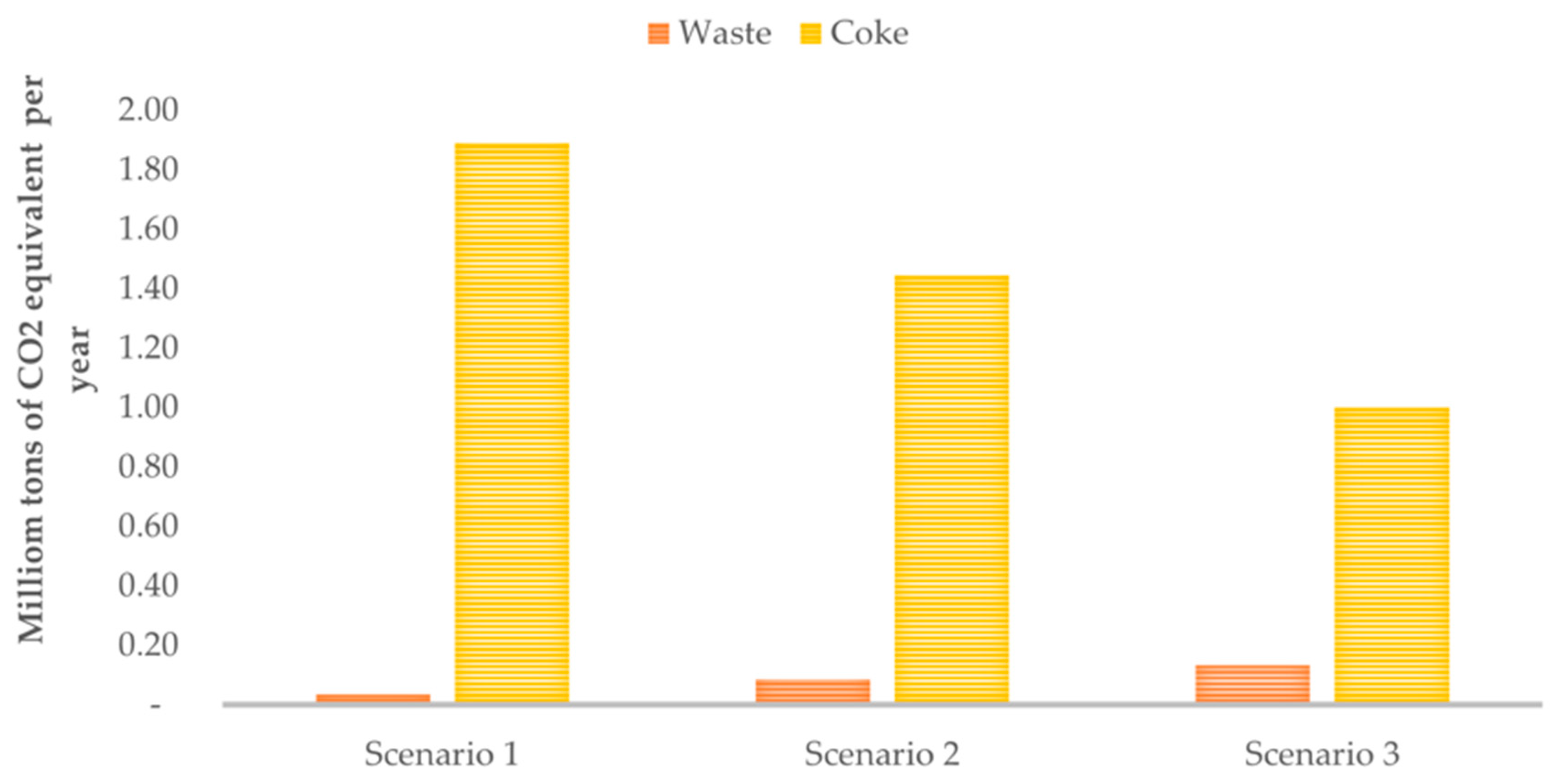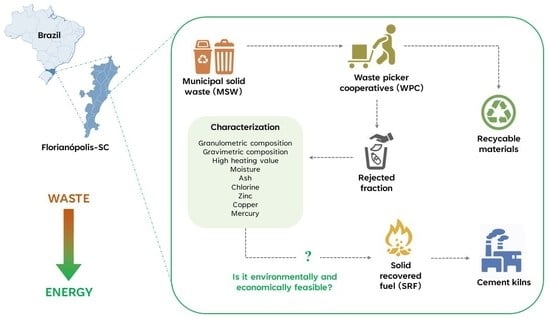Production of Solid Recovered Fuel from the Rejected Fraction of Recyclable Materials from Waste Picker Cooperatives: A Case Study in Brazil
Abstract
:1. Introduction
2. Materials and Methods
2.1. Sample Collection
2.2. Sampling Procedures: Granulometry, Gravimetry, and Physicochemical Analyses
- (a)
- Metallic packaging (e.g., snacks packaging);
- (b)
- Food product packaging 1 (polypropylene (PP) packaging, e.g., pasta and chocolate packaging);
- (c)
- Food product packaging 2 (polyethylene terephthalate (PET) packing, e.g., cake packaging);
- (d)
- Two different materials (packaging made of paper and plastic together);
- (e)
- Styrofoam;
- (f)
- Clothes and shoes;
- (g)
- Organics;
- (h)
- Colored PET packaging;
- (i)
- Paper;
- (j)
- Glass and debris.
2.3. Avoided Emissions
2.4. Economic Evaluation
3. Results
3.1. Granulometric Composition
3.2. Gravimetric Composition
3.3. Chemical Characterization of the Proposed SRF
3.4. Environmental Evaluation
3.4.1. Energy Potential of Waste as SRF
3.4.2. Avoided Atmospheric Emissions
3.5. Economic Evaluation
4. Conclusions
Author Contributions
Funding
Institutional Review Board Statement
Informed Consent Statement
Data Availability Statement
Acknowledgments
Conflicts of Interest
References
- Rutkowski, J.E. Inclusive packaging recycling systems: Improving sustainable waste management for a circular economy. Detritus 2020, 13, 29–46. [Google Scholar] [CrossRef]
- Kaza, S.; Yao, L.C.; Bhada-Tata, P.; Van Woerden, F. What a Waste 2.0: A Global Snapshot of Solid Waste Management to 2050; Urban Development Series; World Bank: Washington, DC, USA, 2018. [Google Scholar]
- Zhao, L.; Giannis, A.; Lam, W.-Y.; Lin, S.-X.; Yin, K.; Yuan, G.-A.; Wang, J.-Y. Characterization of Singapore RDF resources and analysis of their heating value. Sustain. Environ. Res. 2016, 26, 51–54. [Google Scholar] [CrossRef] [Green Version]
- Brazil: Lei No 12.305, de 2 de Agosto de 2010. Available online: https://www.planalto.gov.br/ccivil_03/_ato2007-2010/2010/lei/l12305.htm (accessed on 11 May 2020).
- Fricke, K.; Pereira, C.; Leite, A.; Bagnati, M. Gestão sustentável de Resíduos sólidos Urbanos—Transferência de Experiência Entre a Alemanha e o Brasil. 2015, 389p. Available online: https://www.gov.br/mdr/pt-br/assuntos/saneamento/protegeer/biblioteca/TUBS2015GestosustentveldeRSU_Part2.pdf (accessed on 15 January 2020).
- Jardim, A.; Yoshida, C.; Machado Filho, J.V. Política Nacional, Gestão e Gerenciamento de Resíduos Sólidos. Manole Ltda. 2012, 732p. Available online: https://edisciplinas.usp.br/pluginfile.php/340224/mod_resource/content/1/Juras-Araujo%2C%20Responsabilidade%20compartilhada.pdf (accessed on 25 March 2020).
- Barros, R.M.; Filho, G.L.T.; Moura, J.S.; Pieroni, M.F.; Vieira, F.C.; Lage, L.R.; Mohr, G.S.; Bastos, A.S. Design and implementation study of a Permanent Selective Collection Program (PSCP) on a University campus in Brazil. Resour. Conserv. Recycl. 2013, 80, 97–106. [Google Scholar] [CrossRef]
- Campos, H.K.T. Recycling in Brazil: Challenges and prospects. Resour. Conserv. Recycl. 2014, 85, 130–138. [Google Scholar] [CrossRef]
- Conke, L.S.; Nascimento, E.P.D. A coleta seletiva nas pesquisas brasileiras: Uma avaliação metodológica. Rev. Bras. Gestão Urbana 2018, 10, 199–212. [Google Scholar] [CrossRef] [Green Version]
- Shumal, M.; Jahromi, A.R.T.; Ferdowsi, A.; Dehkordi, S.M.M.N.; Moloudian, A.; Dehnavi, A. Comprehensive analysis of municipal solid waste rejected fractions as a source of Refused Derived Fuel in developing countries (case study of Isfahan–Iran): Environmental Impact and sustainable development. Renew. Energy 2020, 146, 404–413. [Google Scholar] [CrossRef]
- Usón, A.A.; López-Sabirón, A.M.; Ferreira, G.; Sastresa, E.L. Uses of alternative fuels and raw materials in the cement industry as sustainable waste management options. Renew. Sustain. Energy Rev. 2013, 23, 242–260. [Google Scholar] [CrossRef]
- Rahman, A.; Rasul, M.; Khan, M.; Sharma, S. Impact of Alternative Fuels on the Cement Manufacturing Plant Performance: An Overview. Procedia Eng. 2013, 56, 393–400. [Google Scholar] [CrossRef] [Green Version]
- Brazilian National Standards Organization: ABNT NBR 16849—Resíduos Sólidos Urbanos Para Fins Energéticos—Requisitos (Urban Waste for Energy Recovery—Requirements). 2020, 30p. Available online: https://www.abntcatalogo.com.br/pnm.aspx?Q=d3kyZzJDdTZUMUVVTklKZHRpTTd5VjdSOXBKczRET01DaFdISVRqeWtJRT0= (accessed on 11 May 2020).
- Gallardo, A.; Carlos, M.; Bovea, M.; Colomer, F.J.; Albarrán, F. Analysis of refuse-derived fuel from the municipal solid waste reject fraction and its compliance with quality standards. J. Clean. Prod. 2014, 83, 118–125. [Google Scholar] [CrossRef] [Green Version]
- São Paulo: Resolução Sima No 47, de 06 de Agosto de 2020; Secretaria de Estado de Infraestrutura e Meio Ambiente: São Paulo, Brazil, 2020.
- Brás, I.; Silva, M.E.; Lobo, G.; Cordeiro, A.; Faria, M.; de Lemos, L.T. Refuse Derived Fuel from Municipal Solid Waste rejected fractions—A Case Study. Energy Procedia 2017, 120, 349–356. [Google Scholar] [CrossRef] [Green Version]
- Reza, B.; Soltani, A.; Ruparathna, R.; Sadiq, R.; Hewage, K. Environmental and economic aspects of production and utilization of RDF as alternative fuel in cement plants: A case study of Metro Vancouver Waste Management. Resour. Conserv. Recycl. 2013, 81, 105–114. [Google Scholar] [CrossRef]
- Valiullin, T.R.; Egorov, R.I.; Strizhak, P.A. Combustion of the waste-derived fuel compositions metallized by aluminium powder. Combust. Flame 2017, 182, 14–19. [Google Scholar] [CrossRef]
- Kara, M. Environmental and economic advantages associated with the use of RDF in cement kilns. Resour. Conserv. Recycl. 2012, 68, 21–28. [Google Scholar] [CrossRef]
- Al-Moftah, A.M.S.H.; Marsh, R.; Steer, J. Life Cycle Assessment of Solid Recovered Fuel Gasification in the State of Qatar. Chemengineering 2021, 5, 81. [Google Scholar] [CrossRef]
- Martignon, G. Trends in Use of Solid Recovered Fuels. IEA Bioenergy—Summary Series—Task 36 (Report). 2020, 79p. Available online: https://www.ieabioenergy.com/wp-content/uploads/2020/05/Trends-in-use-of-solid-recovered-fuels-Main-Report-Task36.pdf (accessed on 5 January 2021).
- Brazilian National Standards Organization: Resíduos Sólidos—Classificação (Solid waste—Classification). 2004, 77p. Available online: https://www.abntcatalogo.com.br/pnm.aspx?Q=T0pJNTgyRndVYVZNQ1ovVlRiQUlQS3lmek5uampPeHY= (accessed on 11 May 2020).
- Brazilian GHG Protocol Program|FGV EAESP. Available online: https://eaesp.fgv.br/en/study-centers/center-sustainability-studies/projects/brazilian-ghg-protocol-program (accessed on 1 April 2021).
- FGV-EAESP: Programa Brasileiro GHG Protocol|FGV EAESP. Available online: https://eaesp.fgv.br/centros/centro-estudos-sustentabilidade/projetos/programa-brasileiro-ghg-protocol (accessed on 1 April 2021).
- Curitiba: Sistema Integrado e Descentralizado de Tratamento de Resíduos e Disposição Final de Rejeitos dos Municípios que Integram o Consórcio Intermunicipal para Gestão dos Resíduos Sólidos Urbanos (CONRESOL); Estudo de Viabilidade Técnica e Econômico-Financeira (EVTE): Curitiba, Brazil, 2020.
- de Souza, S.N.M.; Pereira, W.C.; Nogueira, C.E.C.; Pavan, A.A.; Sordi, A. Custo da eletricidade gerada em conjunto motor gerador utilizando biogás da suinocultura. Acta Sci. Technol. 2004, 26, 127–133. [Google Scholar] [CrossRef] [Green Version]
- Gallardo, A.; Carlos, M.; Colomer, F.J.; Edo-Alcón, N. Analysis of the waste selective collection at drop-off systems: Case study including the income level and the seasonal variation. Waste Manag. Res. J. Sustain. Circ. Econ. 2018, 36, 30–38. [Google Scholar] [CrossRef] [PubMed] [Green Version]
- Strazza, C.; Del Borghi, A.; Gallo, M.; Del Borghi, M. Resource productivity enhancement as means for promoting cleaner production: Analysis of co-incineration in cement plants through a life cycle approach. J. Clean. Prod. 2011, 19, 1615–1621. [Google Scholar] [CrossRef]
- Chatziaras, N.; Psomopoulos, C.S.; Themelis, N.J. Use of waste derived fuels in cement industry: A review. Manag. Environ. Qual. Int. J. 2016, 27, 178–193. [Google Scholar] [CrossRef]
- Iacovidou, E.; Hahladakis, J.; Deans, I.; Velis, C.; Purnell, P. Technical properties of biomass and solid recovered fuel (SRF) co-fired with coal: Impact on multi-dimensional resource recovery value. Waste Manag. 2018, 73, 535–545. [Google Scholar] [CrossRef]
- Rahman, A.; Rasul, M.; Khan, M.; Sharma, S. Recent development on the uses of alternative fuels in cement manufacturing process. Fuel 2015, 145, 84–99. [Google Scholar] [CrossRef]
- Ranieri, E.; Ionescu, G.; Fedele, A.; Palmieri, E.; Ranieri, A.C.; Campanaro, V. Sampling, characterisation and processing of solid recovered fuel production from municipal solid waste: An Italian plant case study. Waste Manag. Res. J. Sustain. Circ. Econ. 2017, 35, 890–898. [Google Scholar] [CrossRef] [PubMed]
- Viczek, S.A.; Aldrian, A.; Pomberger, R.; Sarc, R. Origins and carriers of Sb, As, Cd, Cl, Cr, Co, Pb, Hg, and Ni in mixed solid waste—A literature-based evaluation. Waste Manag. 2020, 103, 87–112. [Google Scholar] [CrossRef] [PubMed]
- Bessi, C.; Lombardi, L.; Meoni, R.; Canovai, A.; Corti, A. Solid recovered fuel: An experiment on classification and potential applications. Waste Manag. 2016, 47, 184–194. [Google Scholar] [CrossRef] [PubMed]
- Götze, R.; Boldrin, A.; Scheutz, C.; Astrup, T.F. Physico-chemical characterisation of material fractions in household waste: Overview of data in literature. Waste Manag. 2016, 49, 3–14. [Google Scholar] [CrossRef] [PubMed] [Green Version]
- Sarc, R.; Lorber, K.E. Production, quality and quality assurance of Refuse Derived Fuels (RDFs). Waste Manag. 2013, 33, 1825–1834. [Google Scholar] [CrossRef] [PubMed]
- Labidi, A.; Salaberria, A.M.; Fernandes, S.C.; Labidi, J.; Abderrabba, M. Adsorption of copper on chitin-based materials: Kinetic and thermodynamic studies. J. Taiwan Inst. Chem. Eng. 2016, 65, 140–148. [Google Scholar] [CrossRef]
- Nasrullah, M.; Hurme, M.; Oinas, P.; Hannula, J.; Vainikka, P. Influence of input waste feedstock on solid recovered fuel production in a mechanical treatment plant. Fuel Process. Technol. 2017, 163, 35–44. [Google Scholar] [CrossRef]
- Visedo, G.; Pecchio, M. ROADMAP Tecnológico do Cimento: Potencial de Redução das Emissões de Carbono da Indústria do Cimento Brasileira Até 2050. 2019, 64p. Available online: https://coprocessamento.org.br/wp-content/uploads/2019/11/Roadmap_Tecnologico_Cimento_Brasil_Book-1.pdf (accessed on 1 April 2021).





| Year | Recyclable Waste (kg) | Rejected Fraction (kg) | Rejected Fraction (%) |
|---|---|---|---|
| 2017 | 9840.650 | 2029.016 | 20.62 |
| 2018 | 10,340.826 | 2169.382 | 20.98 |
| 2019 | 12,775.690 | 2515.430 | 19.69 |
| 2020 | 11,436.700 | 2346.584 | 20.52 |
| Parameter | Waste Picker Cooperative | ||
|---|---|---|---|
| A | B | C | |
| Ash (%) | 3.81 | 3.79 | 4.35 |
| Moisture (%) | 1.89 | 4.48 | 3.25 |
| Chlorine (%) | 1.81 | 2.44 | 1.86 |
| Zinc (mg/kg) | 67.90 | 66.63 | 62.71 |
| Copper (mg/kg) | - | 17.00 | - |
| Mercury (mg/kg) | 0.383 | 0.069 | 0.152 |
| Unity | USD Scenario A (522 t/day) | USD Scenario B (720 t/day) |
|---|---|---|
| Mechanical treatment unit (grinding, rotary screen, air separator, metal separation, optical sensor, and final grinding) | 4,250,737.06 | 5,863,085.60 |
| Overhead crane | 434,835.88 | 599,773.63 |
| Overflow station | 388,246.32 | 535,512.17 |
| Road scale (30 tons) | 52,426.47 | 72,312.37 |
| Implementation lot | 441,166.40 | 608,505.38 |
| Infrastructure works (gate, access, water, sewage, and power connections) | 79,577.88 | 109,762.59 |
| Environmental compensation | 116,097.84 | 160,134.95 |
| Construction of the administrative support area | 34,684.74 | 47,841.02 |
| Design and construction of the shed that will house the mechanical treatment unit | 513,573.53 | 708,377.28 |
| Permanent stock of imported spare parts | 23,294.12 | 32,129.82 |
| Construction of a shed to stock the SRF produced | 73,367.64 | 101,196.75 |
Disclaimer/Publisher’s Note: The statements, opinions and data contained in all publications are solely those of the individual author(s) and contributor(s) and not of MDPI and/or the editor(s). MDPI and/or the editor(s) disclaim responsibility for any injury to people or property resulting from any ideas, methods, instructions or products referred to in the content. |
© 2023 by the authors. Licensee MDPI, Basel, Switzerland. This article is an open access article distributed under the terms and conditions of the Creative Commons Attribution (CC BY) license (https://creativecommons.org/licenses/by/4.0/).
Share and Cite
Piaia, E.; Cavali, M.; Nadaleti, W.C.; Matias, M.S.; Russo, M.A.T.; de Castilhos Junior, A.B. Production of Solid Recovered Fuel from the Rejected Fraction of Recyclable Materials from Waste Picker Cooperatives: A Case Study in Brazil. Biomass 2023, 3, 238-251. https://doi.org/10.3390/biomass3030014
Piaia E, Cavali M, Nadaleti WC, Matias MS, Russo MAT, de Castilhos Junior AB. Production of Solid Recovered Fuel from the Rejected Fraction of Recyclable Materials from Waste Picker Cooperatives: A Case Study in Brazil. Biomass. 2023; 3(3):238-251. https://doi.org/10.3390/biomass3030014
Chicago/Turabian StylePiaia, Eduarda, Matheus Cavali, Willian Cézar Nadaleti, Marcelo Seleme Matias, Mário Augusto Tavares Russo, and Armando Borges de Castilhos Junior. 2023. "Production of Solid Recovered Fuel from the Rejected Fraction of Recyclable Materials from Waste Picker Cooperatives: A Case Study in Brazil" Biomass 3, no. 3: 238-251. https://doi.org/10.3390/biomass3030014







